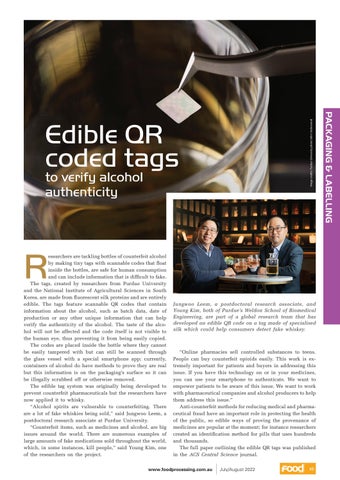Image credits: Purdue University photo/John Underwood
to verify alcohol authenticity
R
esearchers are tackling bottles of counterfeit alcohol by making tiny tags with scannable codes that float inside the bottles, are safe for human consumption and can include information that is difficult to fake. The tags, created by researchers from Purdue University and the National Institute of Agricultural Sciences in South Korea, are made from fluorescent silk proteins and are entirely edible. The tags feature scannable QR codes that contain information about the alcohol, such as batch data, date of production or any other unique information that can help verify the authenticity of the alcohol. The taste of the alcohol will not be affected and the code itself is not visible to the human eye, thus preventing it from being easily copied. The codes are placed inside the bottle where they cannot be easily tampered with but can still be scanned through the glass vessel with a special smartphone app; currently, containers of alcohol do have methods to prove they are real but this information is on the packaging’s surface so it can be illegally scrubbed off or otherwise removed. The edible tag system was originally being developed to prevent counterfeit pharmaceuticals but the researchers have now applied it to whisky. “Alcohol spirits are vulnerable to counterfeiting. There are a lot of fake whiskies being sold,” said Jungwoo Leem, a postdoctoral research associate at Purdue University. “Counterfeit items, such as medicines and alcohol, are big issues around the world. There are numerous examples of large amounts of fake medications sold throughout the world, which, in some instances, kill people,” said Young Kim, one of the researchers on the project.
Jungwoo Leem, a postdoctoral research associate, and Young Kim, both of Purdue’s Weldon School of Biomedical Engineering, are part of a global research team that has developed an edible QR code on a tag made of specialised silk which could help consumers detect fake whiskey.
“Online pharmacies sell controlled substances to teens. People can buy counterfeit opioids easily. This work is extremely important for patients and buyers in addressing this issue. If you have this technology on or in your medicines, you can use your smartphone to authenticate. We want to empower patients to be aware of this issue. We want to work with pharmaceutical companies and alcohol producers to help them address this issue.” Anti-counterfeit methods for reducing medical and pharmaceutical fraud have an important role in protecting the health of the public, so edible ways of proving the provenance of medicines are popular at the moment; for instance researchers created an identification method for pills that uses hundreds and thousands. The full paper outlining the edible QR tags was published in the ACS Central Science journal.
www.foodprocessing.com.au
July/August 2022
45
PACKAGING & LABELLING
Edible QR coded tags
